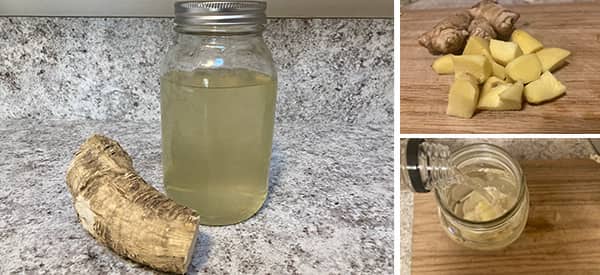
How to Make Horseradish Tincture
Known for its sharp odor and strong taste, horseradish can be divisive in the culinary world. But though the taste may not be for everyone, the nutritional benefits aren’t up for debate.
Distill the nutritive qualities of the plant into a horseradish tincture for a fast-acting health supplement that your body can easily absorb. This horseradish extract is crafted by soaking freshly grated horseradish root in alcohol, typically vodka, which acts as a solvent to draw out the potent compounds responsible for its pungent taste and therapeutic properties.
Belonging to the mustard family, horseradish contains bioactive compounds such as sinigrin, which converts into allyl isothiocyanate when the root is crushed or grated. These compounds contribute to its distinctive taste and are linked to supporting respiratory health by clearing the sinuses and boosting the immune system.
When making the horseradish tincture in smaller batches, it is essential to shake the mixture regularly to ensure the active ingredients fully infuse into the alcohol. This process preserves the tincture’s potency and flavor, making it a valuable addition to your wellness routine.
Typically, a small amount of the horseradish tincture is consumed, often placed under the tongue using a dropper for rapid absorption, or diluted in water or your favorite juice. This method helps the tincture work effectively to support digestion, respiratory function, and immune response.
While horseradish tincture is not intended to diagnose, treat, or cure any disease, many users find it beneficial as a natural supplement. However, it is important to accept and follow warnings: avoid excessive consumption to prevent irritation of the skin or mucous membranes, and pregnant women or individuals with sensitive digestive systems should consult a healthcare professional before use.
Incorporating horseradish tincture into your daily routine can also support skin health, thanks to its antimicrobial properties. Its traditional use across various locations worldwide highlights its versatility as a natural remedy.
Remember to store the tincture in a cool, dark place and always shake well before use to maintain its effectiveness and taste. Whether you choose to ingest it directly, mix it into drinks, or add it to food, horseradish tincture offers a convenient way to harness the benefits of this pungent herb.
What is Horseradish?
Horseradish (Amoracia rusticana) shares the Brassica plant family with many garden-fresh favorites, including broccoli, mustards, and radishes. This perennial plant is native to Southeastern Europe and Western Asia, but is currently grown around the world. In fact, it’s incredibly resilient and can thrive in hardiness zones 1 through 9. The entire plant is edible, but the highest concentration of flavor and nutrients is found in the large tap root.
The name “horseradish” comes from an international game of telephone. In Germany, horseradish grows along the coast, giving it the name “sea radish,” or meerrettich. To an English speaker, the German name sounds like “mare radish,” which eventually evolved into the colloquial name horseradish.
Horseradish Health Benefits
Because of these potent compounds, horseradish tincture is often used as a natural remedy to help treat sinus congestion and other respiratory diseases. The pungent taste and aroma can stimulate mucus flow, providing relief for blocked sinuses and promoting clear breathing. When consuming horseradish tincture, it is generally recommended to take a small amount, often diluted in water or your favorite juice, under the tongue using a dropper for faster absorption. However, caution is advised as it may irritate the skin and mucous membranes if used excessively.
Always accept and follow warnings, especially for pregnant women or those with sensitive digestive systems, and contact a healthcare professional if unsure. While horseradish tincture is not intended to diagnose or cure diseases, many users comment on its effectiveness as a supportive herbal extract in their wellness routines.
Fights Inflammation & Infection
Along with other mustards that share the same chemical compounds, horseradish can help fight chronic inflammation. Sinigrin and its associated chemicals alter the way the immune system creates inflammation, traditionally supporting the body’s natural defense mechanisms.
Additionally, these same compounds have powerful antimicrobial properties. Allyl isothiocyanate, a pungent compound released when the horseradish root is grated or crushed, kills harmful pathogens and effectively boosts your immunity. This makes horseradish tincture a valuable herbal extract for supporting respiratory health and overall immune function.
The horseradish tincture is typically made using alcohol, such as vodka, which acts as a solvent to extract the beneficial compounds from the root. This alcohol-based tincture allows for quick absorption when ingested, often by placing a small amount under the tongue or diluting it in water or your favorite juice. The horseradish tincture work relies on this method of preparation to preserve the potency of the horseradish extract, ensuring that the active ingredients remain effective.
Because horseradish grows in various locations worldwide, its availability and traditional uses vary by region. In many cultures, it has been used traditionally as a natural remedy to treat sinus congestion and support digestion. Incorporating horseradish tincture into your daily routine can help maintain healthy digestion by stimulating bile production and promoting gut health.
When preparing horseradish tincture in smaller batches, it’s important to shake the mixture regularly to ensure the extract fully infuses into the alcohol. This careful preparation helps retain the pungent taste and aroma that characterize horseradish while maximizing its health benefits.
While horseradish tincture offers many advantages, it is important to consume it responsibly. Avoid excessive use, as it may irritate the skin, mucous membranes, or digestive tract. Pregnant women and individuals with sensitive digestive systems should consult a healthcare professional before use. Remember, horseradish tincture is not intended to diagnose, cure, or treat any disease, but it can be a valuable addition to your natural wellness regimen.
Prevents Cell Damage
Horseradish is a great source of natural antioxidants which can neutralize the damaging effects of free radicals. These antioxidants help protect cells from oxidative stress, which is linked to aging and various chronic diseases. Because of this, horseradish prevents cell damage and can reduce the chances of developing some cancers by limiting the damage to DNA and promoting overall cellular health.
Additionally, the antioxidant properties support the immune system by enhancing the body’s ability to fight off infections and inflammation. Regular consumption of horseradish tincture, therefore, not only aids in disease prevention but also contributes to maintaining vitality and well-being.
Promotes Respiratory Health
If you’ve ever eaten horseradish, you’ve likely gotten a burning sensation that makes your nose run and eyes water. While this can be an adventurous part of eating the root, it also can provide some relief from mucus buildup. One study found that taking a supplement with dried horseradish and nasturtium effectively treated both sinus infections and bronchitis.
Nutrition Supplement
Along with its medicinal benefits, horseradish is generally nutritious and can enhance general health as a dietary supplement. The root contains hearty amounts of calcium, fiber, potassium, manganese, folate, magnesium, and vitamin C. Ensure that you get the daily recommended value of each of these important vitamins and minerals, by incorporating a horseradish tincture into your daily routine.
Supports Healthy Digestion
Some of the nutritive properties of horseradish make it a cholagogue. This is any substance that promotes the production and release of bile from the gallbladder. Bile allows the liver to efficiently digest fat and helps the body maintain healthy digestion. Incorporating cholagogue foods, like horseradish into your diet will ensure that your liver and gallbladder are functioning flawlessly.
Additionally, horseradish can boost metabolism. The root contains compounds called isothiocyanates along with high amounts of iron and calcium which all support a healthy metabolism.
How to Make Horseradish Tincture
In this recipe, we use vodka because of its neutral taste and combine the horseradish with a bit of ginger and cloves to create a more complex and palatable tincture. When serving your tincture, you can mix a bit of honey to add some sweetness.
Ingredients and materials
- 3–4-inch section of fresh horseradish root (about 75 grams)
- 1–2-inch section of fresh ginger (about 25 grams)
- Cloves
- 3 cups vodka (750ml bottle)
- Honey (optional)
- Mason jar
- Grater
- Cheesecloth or fine mesh strainer
Step 1: Prepare the Roots. The first step to making a horseradish tincture is to prepare the roots. Rather than tossing a chunk of horseradish in the jar, it’s important to thinly slice it to increase the surface area. The sinigrin is only activated once the root is chopped, so this increases the extraction of the nutritive properties. For the best results, peel the horseradish and slice it into thin discs. If you have a mandoline, that would be perfect. Peel and cut the ginger as well. For this recipe, I just made small chunks.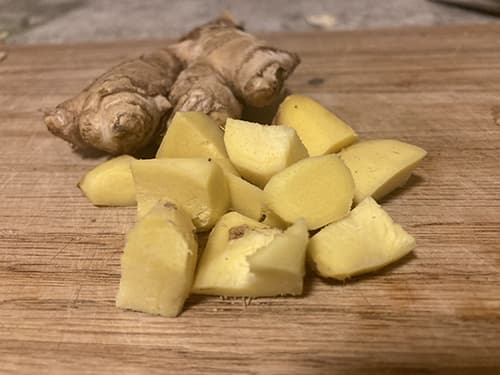
Step 2: Mix in Mason Jar. The next step is to mix your horseradish tincture. Put the sliced horseradish and ginger into a mason jar and sprinkle in a few cloves if you’d like the depth of flavor. Pour in the bottle of vodka and screw the lid on tightly. Give the jar a few shakes to mix thoroughly.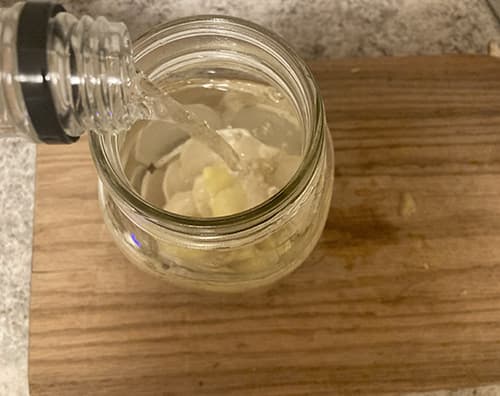
Step 3: Extraction. Store the tincture in a dark place, like a cupboard or closet. Shake the jar at least once per day for the first week, then let sit for up to six weeks. 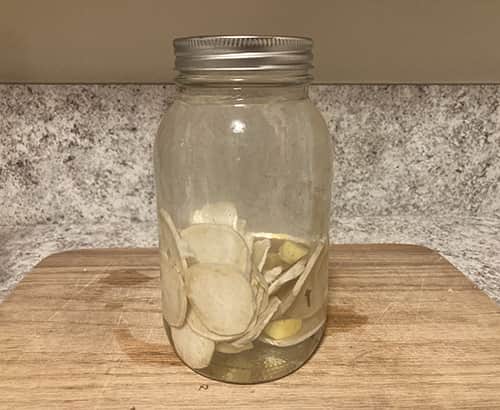
Step 4: Strain. After you’ve let the tincture work its magic, you can strain the roots from the liquid. Using cheesecloth or a fine mesh strainer, pour the contents of the jar into a quart measuring cup. Then, you can pour the tincture in a dropper bottle if you’d like to add to your favorite drink or even food in the future.
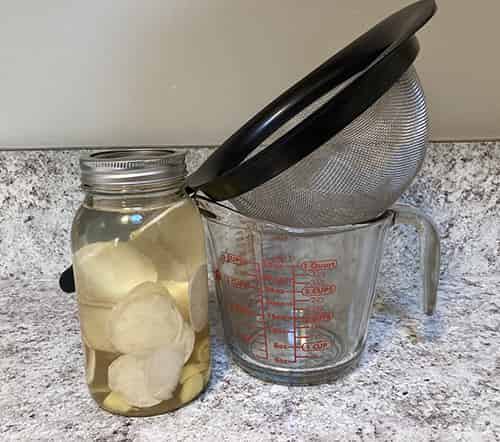
Using Horseradish Tincture
Once you’ve made your extract, you can use it in a variety of ways. If your sinuses are clogged, take 5-10 drops as needed. Depending on the strength of your tincture, you can increase or decrease the dose. For a routine supplement, you can take drops, or incorporate the extract into a homemade fire cider or salad dressing.
Obviously, there is also the option of using horseradish extract, which you can buy online. In this case you would have to dilute it with water or at least follow manufacturer indications.
Warnings and Cautions
Horseradish may be safe to use as medicine for up to 12 weeks. If you take in too much horseradish, it may irritate your mouth, nose, or stomach. Always use small batches first to see if it helps. It may be especially irritating for people suffering from stomach ulcers, digestive problems, or IBS. Finally, it is unknown whether high doses of horseradish are safe for children or pregnant or breastfeeding women. So be safe and avoid it in such situations, especially when you added other ingredients than what we highlighted above.
You may also like:
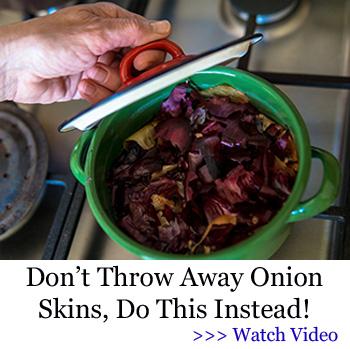 Beetroot Tea for Inflammation and Liver Damage
Beetroot Tea for Inflammation and Liver Damage
The Plants The Cherokees Used For Pain Relief (Video)
How to Make Ginger Syrup for Digestive Issues

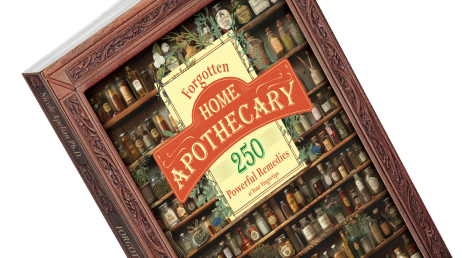






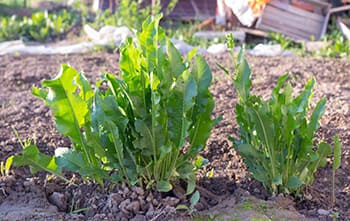
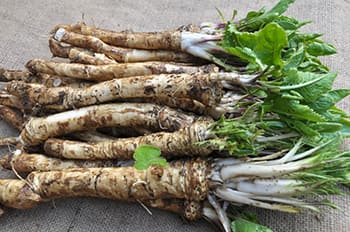
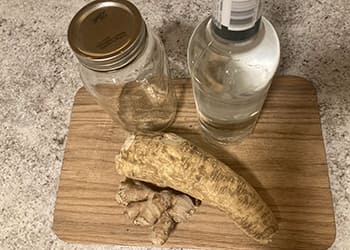
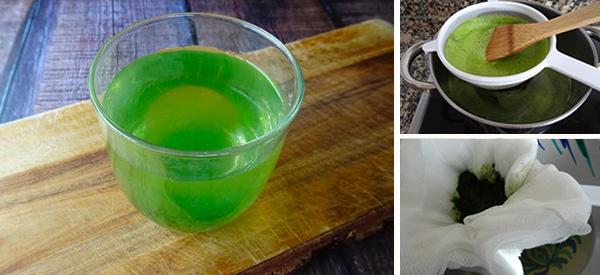

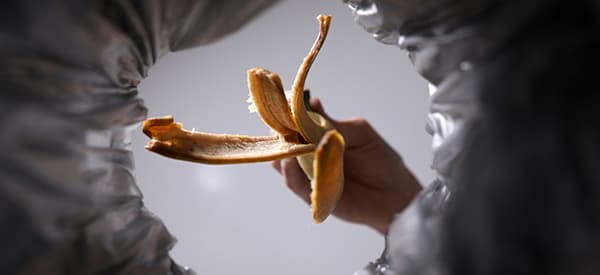
How do you administer the drops of the horse radish tincture, in the sinuses?
Ouch! Don’t attempt to put the drops in your nose! Please add to a bit of water or food and the effect will help decrease inflammation in the nasal membranes.
I’m would think it’s safe to say, you still take it the same way you would take a sinus pill, except in drop form. You don’t put it in your nose.
Traditionally, you add the drops to a small amount of water or juice and drink.. “chug” to get it down quickly. I usually use a couple of ounces of liquid. This is a pretty potent recipe, and I would not do more than just a couple of drops. You can always use more if it isn’t enough, but you can’t undo taking too much!
Under the tongue
Is this tincture good for joint pain?
Hi Linda,
Horseradish helps to stimulate blood flow to both the surface of the skin and beneath it and, thus, helps to alleviate pain. Topically, horseradish can be locally applied to alleviate joint and muscle pain.
Many blessings and good health!
Tinctures require 6 weeks for full extraction. Is there a particular reason this says 5-7 days?
Hi Stephanie, thanks for bringing attention to this, that was a mistake. What we meant to say was to shake the jar every day for 5-7 days, then store for four to six weeks.
Why are the questions rarely answered here? Is there a substitute for vodka?
yes there are a couple of other ‘solvents’ you can use…
i have used homemade wine to extract, ive used glycerine along with water and even spiced rum on its own or a bit of glycerine in with it. you can also use honey as your solvent
Can you use vinegar instead of alcohol?
Hi Diane,
Thank you for your comment. We’re doing our best to answer our readers’ inquiries, but we might not get to answer each and every one due to the high number of comments we’re receiving.
We recommend reading our article below. It’s about how to make a tincture using apple cider vinegar instead of alcohol:
https://thelostherbs.com/how-to-make-a-tincture-using-apple-cider-vinegar-instead-of-alcohol/
Many blessings and good health!
any 80 proof alcohol or higher or vegetable glycerin
Do you have a book with all of these collected in it?
nicole has a book out the lost book of herbal remedies it tells you how to make tinctures and extracts etc. as most herbal books do give you details on how to do it
I usually use 90 – 100 proof Vodka for tinctures, is that what this recipe is calling for?
Hi Steph,
Thank you for your interest in this article.
Yes, 90-100 proof Vodka is perfect. We recommend working with an alcohol that is between 40-60% ABV (80-120 proof) to capture the widest range of both water soluble and alcohol soluble constituents. The majority of vodka, brandy, rum, and gin fall within that range.
Many blessings and good health!
Honestly, I wouldn’t use a horseradish tincture at all.
I would rather make Fire Cider, using horseradish in it and take that daily. It has many other ingredients that are very beneficial as well.
Rosemary Gladstar and Mountain Rose Herbs has a great recipe on the blog. There is also a book of many different FC recipes. MRH carries it.
Or
Just make some horseradish sauce, and eat it on your beef.
I wouldn’t use most prepared horseradish in stores as they contain other ingredients that aren’t healthy.
Personally, I use the Fire Cider. I have 2 gallons going right now, ready in another 4 weeks.
Using up the last of last years batch.
Sounds great, thanks for sharing, when making a tincture would it not be better to grate the roots?